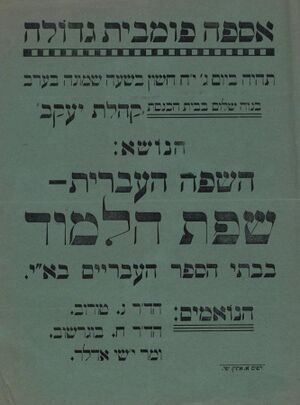War of the Languages
Topic: Social
 From HandWiki - Reading time: 3 min
From HandWiki - Reading time: 3 min
The war of the languages (Hebrew: מלחמת השפות; Milhemet HaSafot) was a heated debate in the land of Israel over the language of instruction in the country's new Jewish schools. This "language war" was a cornerstone event in the history of the revival of the Hebrew language.
Background
In 1904, Hebrew was the language of instruction in 6 of the 29 organized schools in the Land of Israel. In 1908, it was decided to establish the first professional post-secondary institution in Israel, from which the Technion later grew. The name choosen for the new institution was Technikum (Hebrew: טכניקום), that was meant to educate and train skilled workers (Work managers, technicians, assistant engineers). In addition, a school with two majors, a technical major and a practical major, was to be established alongside it.
History
In 1913, the German Jewish aid agency Hilfsverein der deutschen Juden, which had maintained schools for Jewish immigrants in Palestine since 1905, sought to establish German as the language of instruction at the first technical high school, the Technikum, in Haifa (later, the Technion), which it was sponsoring.[1][2] This sparked a public controversy between those who supported the use of German and those who believed that Hebrew should be the language spoken by the Jewish people in their homeland. The issue was not just ideological, because until then, Hebrew was primarily a liturgical language and lacked modern technical terms.[3]
The Haifa City Museum produced an exhibit on the "War of the Languages" curated by Svetlana Reingold, in 2011.[4]
See also
- Languages of Israel
- Education in Israel
- Culture of Israel
References
- ↑ Spolsky, Bernard, and Elana Shohamy (2001). "The Penetration of English as Language of Science and Technology into the Israeli Linguistic Repertoire: A Preliminary Inquiry", in: Ulrich Ammon (Ed.), The Dominance of English as a Language of Science: Effects on Other Languages and Language Communities. Berlin: Mouton de Gruyter. ISBN:311016647X. p. 167-176; here: p. 169.
- ↑ Kremer, Arndt (January 30, 2015). "Brisante Sprache? Deutsch in Palästina und Israel" (in German). Section "Frühe Siedlungen, erste Kontroversen". Aus Politik und Zeitgeschichte. Bundeszentrale für politische Bildung. www.bpb.de. Retrieved 2016-10-05.
- ↑ How German built the Hebrew language
- ↑ Parasczczuk, Joanna (25 March 2011). "With words, not weapons". Jerusalem Post. ProQuest 860862075.
External links
 |
 KSF
KSF
